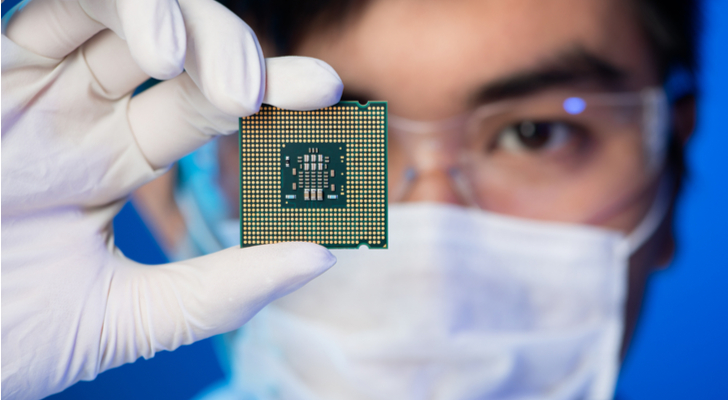There’s no shortage of “buy the dip” candidates among semiconductor stocks. Equipment manufacturer Applied Materials (NASDAQ:AMAT) is one of them. AMAT stock has pulled back over 40% from its early-year highs, and Applied Materials stock now trades at a seemingly reasonable forward price- earnings multiple of eight.
But AMAT isn’t a stock investors should buy just because it’s “cheap.” Semiconductor stocks like Applied Materials and rival Lam Research (NASDAQ:LRCX) are notoriously cyclical. In theory, anyway, price-earnings multiples should shrink at the top of the cycle. And it’s clear that investors are pricing that top into AMAT, LRCX, and numerous other chip stocks.
The question at the moment is whether semiconductor stocks’ multiples should be dropping. Clearly, near-term pressures are hurting the sector. But AMAT bulls – and AMAT’s management – think those pressures will probably fade within a few quarters. If they’re right – if the semiconductor business is just hitting a lull and not headed for a plunge – Applied Materials stock should have solid mid- and long-term upside.
The Cyclical Problem Facing AMAT Stock
For the most part, it’s been sectorwide pressures, not execution, that has pressured AMAT stock over the past eight months. Applied Materials itself continues to perform rather well. It’s gained market share in five of the last six years, according to statements made during the company’s fourth-quarter conference call. This month, InvestorPlace’s Dana Blankenhorn highlighted the company’s underperformance against KLA-Tencor (NASDAQ:KLAC). Applied Materials does seem to have made some progress closing that gap, however, and has developed a strong franchise, particularly in memory chip equipment.
Unfortunately, memory chips are the most cyclical space in semiconductors, as shown by the fact that AMAT’s customer, Micron Technology (NASDAQ:MU), is trading at a forward price-earnings multiple of four. And Micron and other suppliers have promised that – this time – they won’t build excessive capacity when the cycle has reached its top.
So it’s no surprise that the chart of AMAT stock looks an awful like that of MU (though AMAT stock started heading south first). Nor is AMAT stock necessarily cheap. Cyclical businesses should receive low multiples at the top of cycles. The question is whether the industry – and demand for Applied Materials’ equipment – are at a top.
The Cyclical Case for Applied Materials Stock
One shift has driven much of the carnage in semiconductor stocks over the past few months. Investors were starting to believe that the industry simply wasn’t cyclical anymore. that “this time was different.” According to this theory, multiple long-term demand drivers – Big Data, Internet of Things, etc. – would drive growth for years to come. The huge valuation assigned to Nvidia (NASDAQ:NVDA) reflected this optimism; the nearly 50% decline of that stock shows how much sentiment towards the sector has changed.
Indeed, as I wrote back in February, Credit Suisse analysts argued that even equipment makers like Lam Research and Applied Materials were poised for higher growth and lower cyclical volatility. The firm even argued that semi stocks could look to go private, even though that’s historically been an option only for more stable businesses.
Recent trading suggests that investors have completely dismissed that notion. But perhaps they shouldn’t. Much of the good news that drove investors to re-rate chip stocks in 2017 remains intact. Demand for memory should still rise over the long-term. Cloud computing will continue to grow for years. Industrial and automotive applications have a great deal of room to expand.
It’s too optimistic to say that semiconductors are no longer cyclical at all. Conversely, it might be too pessimistic to – as investors appear to be doing at the moment – see the space as “same old, same old”. AMAT’s management insisted on the company’s Q4 earnings call that there were some short-term pressures, but that the long-term outlook remained solid. CFO Dan Durn even said that Q1 (the company’s December quarter) numbers “may prove to be the low point of the year.”
So even if there are still cycles, they may be more moderate than in the past. Yet AMAT stock price suggests nothing has really changed.
Why AMAT Stock?
For investors who see the chip selloff as overdone, AMAT stock looks like an interesting contrarian bet. Indeed, Applied Materials stock has bounced almost 20% after hitting a nearly two-year low in late October.
The interesting question relative to that thesis, however, is whether AMAT stock is the best contrarian play in the sector. NVDA still has growth opportunities and now trades for less than 20 times its earnings. MU, as noted, has a price-earnings multiple which is roughly half that of AMAT. KLAC has better margins and a still-reasonable price-earnings ratio of under 11.
That said, the case for AMAT is that it provides exposure to close to the entire space. Chip stocks can rally, but if memory prices don’t, MU could keep falling. Nvidia is battling for market share with Advanced Micro Devices (NASDAQ:AMD) and Intel (NASDAQ:INTC).
By contrast, Applied Materials’ diversified exposure means it will probably win if the chip space on the whole wins. And AMAT stock is cheaper than its rivals, perhaps limiting its downside somewhat.
Again, an investor has to believe in a semiconductor rebound to even consider buying AMAT stock. But for the believers, Applied Materials stock might be the best name to buy.
As of this writing, Vince Martin has no positions in any securities mentioned.

